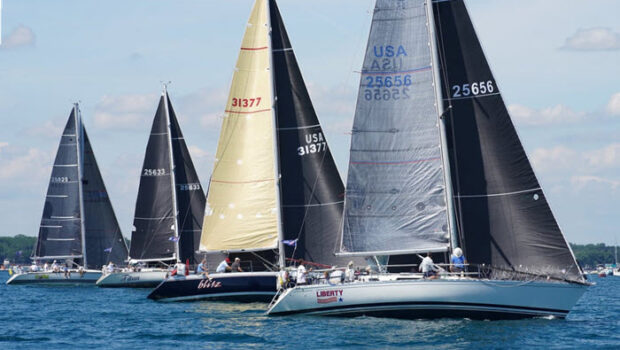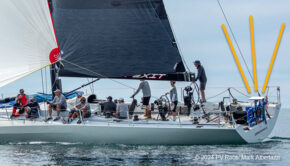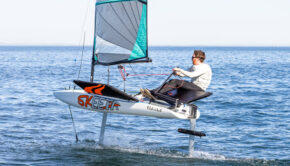Virtual marks and electronic finishes
Published on November 21st, 2023
Necessity has been said to be the mother of invention, innovation and creativity. During the 2020 pandemic, Bayview Yacht Club faced restructuring or reinventing how the Bayview Mackinac Race was run. With the approval of the US Sailing Racing Rules Committee, Bayview YC was able to redefine Finish by using an experimental rule so that trackers could be utilized.
Additionally, a virtual gate was implemented when the government mark was removed as new technologies rendered it obsolete for marine traffic. Appendix WP addresses how to define a mark when using a virtual gate. Here is the report from the 2023 PRO Bruce Bingman, a National Race Officer in the USA:
BACKGROUND:
The Bayview Mackinac Race is a point-to-point race from a start near Port Huron, Michigan to a finish off Mackinac Island, Michigan. There are two courses: a shorter 204nm Shore course for the smaller boats and a longer 290nm Cove Island course requiring the larger boats to go to the eastern side of Lake Huron before heading to the finish.
In prior years the finish line had been fully staffed and a Canadian Government mark had been used as a rounding mark to define the longer course. Due to the COVID pandemic and the Canadian Government no longer maintaining the mark, trackers were used to determine proper virtual mark roundings and finishes.
Use of both the tracker and virtual marks was successful, resulting in accurate finishes and at considerable cost savings over having a fully staffed 24 hour a day finish trailer on Mackinac Island. As the 100th anniversary race approaches, the Organizing Authority (OA) plans to continue use of virtual marks and trackers for the foreseeable future.
DISCUSSION:
The previous method of having a crew in a closed trailer for finishing boats was not feasible because of the COVID pandemic in 2020. The OA decided to try using a virtual finish and to use a tracking program to finish the boats.
Additionally, the Canadian Government stopped maintaining the mark previously used as the rounding mark for the Cove Island course, so the OA desired to use the tracking program to verify the boats on the longer course passed through a virtual gate in the position of the former government mark.
Use of the tracker to cross a virtual finish line required a change to the definition of finish since the tracker would not be the first part of the hull, crew or equipment to cross the finish line; however, RRS 86.1(a) would normally prohibit a change to the definitions.
The Bayview Yacht Club OA requested and received special permission from the US Sailing Racing Rules Committee under RRS 86.3 to change the definition of finish to when the tracking device crossed the virtual finish line. The NOR and SI’s specified that the trackers were required to be mounted on the backstay or stern rail of the competing vessels.
DETAILS:
The 2023 Bayview Mackinac Race was held on July 15-18. The start line was between two anchored signal boats approximately 3.5nm from the Port Huron Yacht Club marina. There were approximately 200 competitors split into 16 classes. The wind was southerly and ranged from 7 to 14 knots through the 2-hour starting sequence so all starts were downwind. The starting line was set square to the average of the rhumb lines for the two courses. There were no OCS boats and no general recalls.
The virtual gate was set near the eastern shore of Lake Huron approximately 130nm at 020 degrees from the start and was 1nm wide. The finish was between a government mark and the SE point of Mackinac Island and was approximately 0.5nm long at an angle of 180 degrees. Finishes were determined electronically using a function in the Yellow Brick tracking system. Competitors were also required to photograph their own GPS instrumentation when they crossed the finish. This proved to be a very important requirement.
For this event, in the areas where the Yellow Brick trackers were used to verify mark roundings or finishes, the position sampling frequency was increased to approximately once per second (although this is not shown on the competitors track that can be publicly viewed). These detailed tracks were available from the Yellow Brick administrator to the finish officer.
The Yellow Brick trackers worked well in showing all competitors passing through the virtual gate on the long (Cove Island) course. The trackers clearly showed finish tracks and finish times in all but four instances where the competitor track crossing the finish line was uncertain and no finish time was automatically recorded.
The Yellow Brick administrator was contacted for the detailed tracks for these four cases. In two cases, the detailed administrator’s tracks showed the boat finishing and time of finish. In the other two cases, finish using the detailed track was indeterminate and reference to the competitors’ GPS photos was made. In both cases, the competitors’ GPS showed a proper finish.
However, in one case, the GPS photo submitted did not show the finish time and reference to times on the public tracks of the nearby boats was made to determine a finish time. The boat in question felt the posted time of finish was incorrect. Upon request, they submitted a second photo showing both GPS time and finish position.
A review showed that the Yellow Brick public tracks can update on different timing cycles and interpolation of timing using public tracks may not be correct. The competitor’s finish time was updated and their correct finish position documented.
In each of these cases, the competitors had turned back very quickly after crossing the finish line which likely may have contributed to the indeterminate nature of the tracks. There were no further scoring inquiries, requests for redress or protests.
CONCLUSIONS:
I conclude that the use of the Yellow Brick trackers was successful and resulted in significant savings in time and resources through use of modern electronics. However, as noted above, the technology is still evolving and to ensure fair racing to all competitors, Organizing Authorities desiring to use trackers in this manner for the future should note the following:
1. Use of the rapid sampling feature is clearly necessary in the vicinity of virtual gates or finishes.
2. Competitors should pass at least 8 to 10 boat lengths beyond the finish line before turning back on their track if the course to the finish port passes back through the finish line.
3. Competitors should be required to take photographs of their GPS screen showing both time and position of their passing virtual gates or finishing as a backup.
If virtual marks or waypoints are used, the NOR should invoke Appendix WP.









 We’ll keep your information safe.
We’ll keep your information safe.